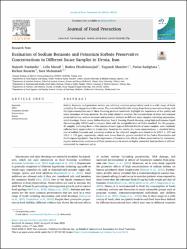Evaluation of sodium benzoate and potassium sorbate preservative concentrations in different sauce samples in Urmia, Iran

Göster/
Erişim
info:eu-repo/semantics/openAccessTarih
2023Yazar
Yazdanfar, NajmehMana, Leila
Ebrahiminejad, Boshra
Mazaheri, Yeganeh
Sadighara, Parisa
Başaran, Burhan
Mohamadi, Sara
Üst veri
Tüm öğe kaydını gösterKünye
Yazdanfar, N., Manafi, L., Ebrahiminejad, B., Mazaheri, Y., Sadighara, P., Basaran, B., & Mohamadi, S. (2023). Evaluation of Sodium Benzoate and Potassium Sorbate Preservative Concentrations in Different Sauce Samples in Urmia, Iran. Journal of food protection, 86(8), 100118. https://doi.org/10.1016/j.jfp.2023.100118Özet
Sodium benzoate and potassium sorbate are relatively common preservatives used in a wide range of foods including flavoring products like sauces. The potential health risks arising from these preservatives along with the high-consumption rate of these flavoring products worldwide highlight the importance of the quality and safety assurance of these products. So, this study aimed to evaluate the concentrations of these two common preservatives (i.e., sodium benzoate and potassium sorbate) in different sauce samples, including mayonnaise, salad dressings, Caesar sauce, Italian dressing, Ranch dressing, French dressing, using high-performance liquid chromatography (HPLC) and to compare them with the acceptable level of Codex standard. For this purpose, 49 samples, including three to five samples of each type of different brands of sauce samples, were randomly collected from supermarkets in Urmia, Iran. Based on the results, the mean concentrations & PLUSMN; standard deviation of sodium benzoate and potassium sorbate in the collected samples were found to be 249.9 & PLUSMN; 157 and 158.0 & PLUSMN; 131 ppm, respectively, which were lower than the general standard of the Codex Alimentarius and the European legislation. Due to the importance of hazardous side effects of these preservatives for consumers, regular and accurate evaluation of these preservatives in sauces as highly consumed food products is still recommended for consumer safety.

















